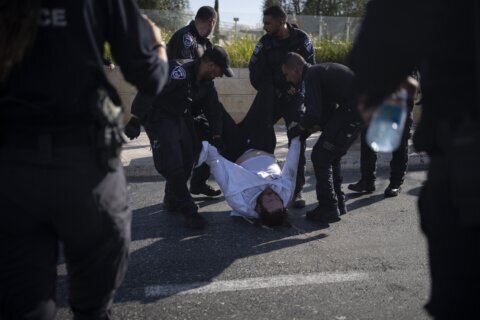More than 2,300 people died from excessive heat in 2023, which is a new record, according to an analysis of Centers for Disease Control and Prevention data by the Associated Press. With extreme heat reaching more parts of the country, heat illnesses like heat stroke, which can be fatal, will affect an even larger number of people.
Heat stroke is the most severe form of heat-related illness and a medical emergency.
“The body absorbs more heat than it can get rid of through sweating, and its temperature rises rapidly,” explains Dr. Jared Braunstein, a board-certified internist with the Medical Offices of Manhattan in New York City and a contributor to LabFinder.com. “When the body’s temperature reaches 104 (degrees) F or higher, heat stroke can occur.”
The body’s temperature can rise to a dangerous level in as little as 10 to 15 minutes, according to the CDC. Without the right treatment, heat stroke can lead to permanent disability, organ damage or death.
Heat exhaustion, which is less severe than heat stroke, also occurs when the body can’t cool itself down. Symptoms of heat exhaustion include a headache, a faster heart rate and feeling weaker.
“It’s important to recognize the need to cool off with these symptoms because heat exhaustion may lead to heat stroke,” says Dr. Stephen Vogel, a family medicine physician with PlushCare, a virtual health platform specializing in primary care, therapy and weight management.
[SEE: 8 Ways to Stay Hydrated Besides Drinking Water.]
Heat Stroke Symptoms
Symptoms of heat stroke include:
— Confusion
— Losing consciousness
— Having a seizure
— Having a body temperature of at least 104 degrees F
— Hot, dry skin
— Slurred speech
Heat Stroke Causes and Risk Factors
As you might expect, heat stroke is caused by excessive heat and the body’s inability to manage the heat. This may happen when exercising or working in the heat, but it also could happen even if you’re in the heat and sedentary.
With heat waves sweeping parts of the country unused to higher temperatures, “some people may not be aware of how dangerous that really is,” notes Steven P. Furr, a family physician in Jackson, Alabama, and president of the American Academy of Family Physicians.
Some people are more vulnerable to heat stroke, including those who:
— Are over age 65
— Are pregnant
— Are young children, as they may not pay attention to feeling the heat
— Have chronic medical conditions, such as congestive heart failure, diabetes or severe high blood pressure
— Use certain medications that make you more heat-sensitive, such as certain blood pressure medicines, mood stabilizers and antipsychotics. The list of medications that can raise your risk to the heat is long, so it’s something you’ll want to discuss with your health care provider, especially when you know you’ll be exposed to the heat.
[See: Best Products for Summer Health Hazards]
Heat Stroke vs. Heat Exhaustion
What to Do If Someone Is Having a Heat Stroke
If you think someone is having a heat stroke, call 911 or seek medical attention right away.
Here’s what else you should do if you’re with someone having a heat stroke:
— Get them somewhere cooler, preferably indoors with air conditioning or even in the shade.
— Elevate their legs slightly to bring blood flow back to the heart.
— If you have a thermometer, check their temperature. You can’t always tell if someone has a high temperature based on if they are sweating.
— Offer as much hydration as possible.
— Immerse them in cold or ice water, which is the most effective treatment for heat stroke, Braunstein says. If that’s not possible, put cool towels on them. Change the towels frequently to maintain their coolness. You also can pour cool water on them or blow air on their wet skin.
[Do Ice Baths Work for Recovery?]
Treating Heat Stroke
Once a person with heat stroke is at a medical facility, doctors and staff members will take many measures to cool the body as quickly as possible, Vogel says. This includes:
— Blowing fans on their wet skin
— Giving cooled IV fluids
— Placing the patient on a cooling mattress
— Putting cool towels on a person
— Submerging them in an ice bath
— Running tests for organ damage and treating any damage as needed
“If performed quickly, heat stroke treatments are very effective,” Vogel says. “Like many other health crises, though, time is of the essence, and complications can arise even with prompt treatment.”
It can take several hours to get the body back to a normal temperature, but the exact amount of time varies for each person. For several days or a week after having a heat stroke, a person with heat stroke still will be sensitive to heat and should avoid hot weather and physical activity.
Preventing Heat Stroke
Heat stroke is serious, but fortunately, there are many things you can do to help prevent it, including the following:
— When reviewing the weather, check the heat index. For instance, the temperature outside may be 90 degrees, but the heat index may be 97 degrees. A heat index starting at 90 degrees can raise the risk of heat stroke, according to the National Weather Service. Exercise more caution if you must go outside when the temperature and/or the heat index is higher.
— Drink water at least every 15 minutes when you’re outside in the heat. Sports drinks are also recommended for people who are exercising in the heat. If you’re drinking anything other than water, avoid caffeine and alcohol as they pull fluid away from the body.
— Wear loose, lightweight and light-colored clothing. Clothing choices can impact how warm your body gets. Light-colored clothes will reflect the sun, while dark-colored clothes will absorb heat and make you feel warmer.
— Use sunscreen with an SPF of at least 15. This will reduce your risk of sunburn, which can make it harder for your body to cool itself off. You can also wear a wide-brimmed hat for sun and heat protection.
— Find shade or air conditioning. If you feel dizzy, nauseated or weak while outside in the heat, get to a cooler area to help your body cool back down. Shade is a good option, but a public restroom with air conditioning can be even better.
— If you must work in the heat, try to start earlier in the day and stop earlier to avoid the worst of the heat. Waking up earlier to get in your physical activity or any outdoor work can save you from the worst of the afternoon heat.
— Keep your car cool when not driving. To do this, crack your windows slightly before leaving the car, and place a sun visor on your front windshield. “That will make a 10- to 15-degree difference,” Furr says.
— Have a backup plan to stay cool during a natural disaster. Furr shares the example of someone losing power for a couple of days after a hurricane. Depending on how hot it is, someone living without the AC could raise the risk of heat-related illness. If you or someone you live with is more sensitive to heat, you may want to consider evacuating so you can be somewhere with consistent air conditioning.
More from U.S. News
Proven Health Benefits of Blueberries
Health Benefits of Watermelon and Ways to Enjoy
Health Questions to Ask Your Doctor
Signs of Heat Stroke and Hot Weather Safety Tips originally appeared on usnews.com







